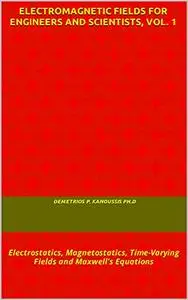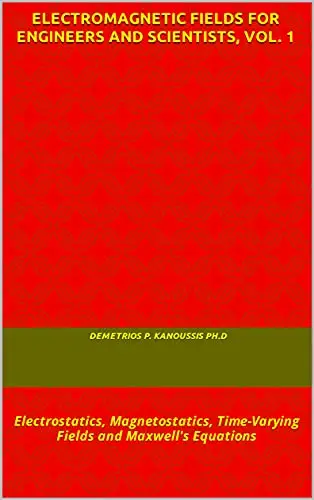ELECTROMAGNETIC FIELDS FOR ENGINEERS AND SCIENTISTS: Electrostatics, Magnetostatics, Time-Varying Fields and Maxwell's Equations by Demetrios P. Kanoussis Ph.D
English | 2021 | ISBN: N/A | ASIN: B09GL7S1DT | 854 pages | PDF | 6.66 Mb
English | 2021 | ISBN: N/A | ASIN: B09GL7S1DT | 854 pages | PDF | 6.66 Mb
The central theme in this book is the development of Maxwell’s equations, the fundamental equations of Electromagnetic fields. Newton’s equations in Mechanics and Maxwell’s equations in Electromagnetism are among the most influential equations in science and technology.
For this reason, Electromagnetism is one of the most fundamental subjects in an engineering curriculum with a huge number of applications. Capacitors and inductors, transmission lines, radiating systems (antennas), microwaves, lasers, motion of charged particles in electric and magnetic fields, propagation of electromagnetic waves in various media, transmission of electromagnetic energy, just to mention a few, are investigated and analyzed by means of Maxwell’s equations.
In this book we use the so called “historical approach” of developing Maxwell’s equations. We start with the relevant experimental laws, (Coulomb’s law, Gauss’s law, Biot-Savart law, Ampere’s circuital law, Faraday’s law of induction, etc), and gradually, step by step, build Maxwell’s equations. This method of approach has the advantage of introducing the student, gradually, not only to the pertinent physical laws but, also, to the mathematical methods and techniques, necessary for the manipulation of various problems in electromagnetism.
For the interested reader, at the Appendix, we present "an axiomatic derivation" of Maxwell’s equations. Taking this approach, the totality of our knowledge and experience with electromagnetic phenomena is summarized into four postulates, which, in conjunction with the principle of conservation of energy, lead directly to Maxwell’s equations.
The book contains 25 chapters, 245 fully solved examples and 867 problems for solution. Odd numbered problems are provided with answers. Chapter 1 is devoted to a brief, but systematic review of vectors and vector analysis. The three most commonly used coordinate systems, i.e. Cartesian, Cylindrical and Spherical, are presented in details. Expressions for the gradient, the divergence, the curl and the Laplacian in all coordinate systems are provided, and their physical significance is considered. The two fundamental theorems of vector analysis, i.e. the Gauss-Ostrogradsky theorem and the Stokes’ theorem (which are used frequently in this book), are presented and analyzed in dtails. The book is mathematically self- contained.
The rest of the book is divided in three parts:
Part A, (Chapters 2,…,12), Electrostatics
Part B, (Chapters 13,…,23), Magnetostatics and
Part C, (Chapters 24, 25), Time –Varying fields and Maxwell’s equations.
The topics covered in the book are described in the Table of contents.
At the end of each section is a set of fully solved examples, followed by a set of problems for solution. At the end of each chapter is an additional set of supplementary problems, (usually more difficult). The students are urged to study carefully the solved examples and solve the problems. This is essential to understanding the material covered in this book.
A second volume, covering propagation of electromagnetic waves in various media, waveguides, transmission lines, simple radiating systems and many other applications of Maxwell's theory, is to be published in the near future.
Feel Free to contact me for book requests, informations or feedbacks.
Without You And Your Support We Can’t Continue
Thanks For Buying Premium From My Links For Support
Without You And Your Support We Can’t Continue
Thanks For Buying Premium From My Links For Support



